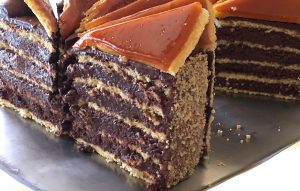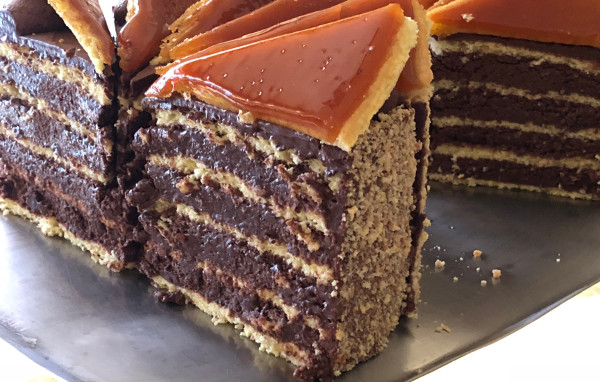
One of my most favorite desserts growing up was the seven-layer cake we bought at Giant, the local grocery store. Yellow cake. Chocolate icing. Heaven. Along with Hostess cupcakes and Suzy Qs, was this not another of the crimes committed against the potential sophistication of the palettes of kids growing up in America the 60s and 70s? Real seven-layer cake was invented in Hungary by József Dobos in the 1880s. For those of you who, like me, don’t speak Hungarian, Dobos Torte does not translate to “seven layers”. It’s the name of the guy, and then “cake”. In any case, the fact is that in most cases it has, admittedly, five layers (where 1 layer of cake + 1 layer of icing = 1 layer). So just call it Dobos (that’s “DOH-bohsh”).
Genius In Plain Sight
In contrast to Palacsinta, the genius of Dobos is completely unhidden. Everything is in plain sight. Chocolate layer cake is what it looks like. The extra genius of Dobos may be found in four places. To start with, while the cake layers are recognizably cake, they are distinctly thin, maybe a third of an inch. What this does is facilitate a mixture of chocolate and cake in the mouth that is more unified and interesting (and chocolaty) than just a typical two-layer cake.
The second location of genius is in the icing. It is a chocolate buttercream. Many American buttercreams stray into butteryness. Not Dobos. Its buttercream (which Mr. Dobos is also reported to have invented) is light, bordering on fluffy, but unyielding in its commitment to chocolate.
The third genius is there on the sides, and you may not even notice it at first. The sides are covered with a dusting of ground nuts, maybe walnut or almond, chestnut or hazelnut. The flavor and texture of the nut makes a late entrance. If you are eating your slice of Dobos from the narrow end to the fat end, the ground nuts suddenly rejuvenate the flavor, take it to a new level of pleasure. The final genius, a particularly Hungarian genius, is the wafer-stiffened caramel top, that sits atop the top layer. (More on this later.)
I thought I recalled having Dobos once with my grandmother out at a local bakery in Queens. But the slice was square, not a wedge, and I don’t remember a proper Dobos top, so that may well have been just plain old seven-layer cake.
Layers And Mixtures
The Dobos I’ve delighted in more recently is here at the Hungarian Pastry Shop in Manhattan (where I am writing this). It is a round cake cut into wedges. Capping each wedge is that special top, a triangle that crunches a bit like a wafer, but that’s really mostly caramel. What to do with this top? I have tried just treating it without prejudice, taking my fork to the cake top and all. But this usually leaves the cake mashed and the caramel top still whole. I have tried removing the top and setting it aside. But this sort of segregation does not satisfy. I either end up not getting to it, or taking a bite or two, being overwhelmed by the sugary caramel, and putting my fork down in surrender. Sometimes I remove it and cut it up with my fork, then take some with each forkful of cake. That’s probably the most enjoyable.
I read somewhere that the cake was shipped widely across Europe, and that Dobos’s caramel-wafer top functioned to seal in moisture and help keep the cake fresh through these journeys. But I wonder if this brilliant, utilitarian, caramel stroke, an extra layer atop the layers, yet a layer with its own striking identity, maybe also had something to do with the extraordinary ethnic diversity of Hungary in the later 19th and early 20th centuries. A number of other Hungarian desserts also work with layers and with mixtures (Flódni comes to mind). Consciously or not, it seems to me that the layering, and the mixtures of diverse and sometimes unexpected-yet-delicious additions, reflect and celebrate the may peoples of Hungary at the time.
I wonder what Dobos would have to say about that.
Buy the book, Finding Maria (Chickadee Prince Books, 2017), now on Amazon
Photo by author. Cake by Hungarian Pastry Shop, 1030 Amsterdam Avenue, New York.
Buy the book, Finding Maria (Bloomingdale Press – 2nd edition November 25, 2019), on Amazon

